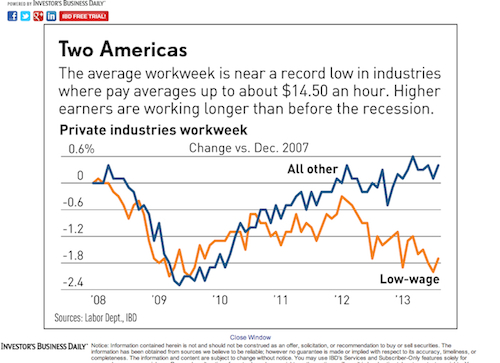Critics of the Affordable Care Act have claimed employers are pushing some workers, especially lower-paid workers, into 29 hours or less of work each week so they can avoid providing healthcare insurance for these workers. Not so, say the White House and its supporters. Republican Sen. Ted Cruz, among others, has said it is so. Richard Trumka, the AFL-CIO president, says it shows the need to adjust the law.
So, what do the facts show?
Since late October, Jed Graham of Investor’s Business Daily has been gathering and examining data in an effort to cast light on this fog of claims and counterclaims. Graham went to the Bureau of Labor Statistics online database, which has finely detailed data on hours worked, and hourly pay, by industry. He spent a day or so analyzing the data in a spreadsheet and found that–surprise!–the facts are more subtle and complex than the sound bytes from the White House, its supporters and its critics.
First, it turns out the Obama administration has been rounding up, counting workers at 29.5 hours as putting in 30 hours–which Graham characterizes as misleading, at best. Graham’s analysis shows that low-wage employees, those making $14.50 and hour or less, are indeed working fewer hours, while higher paid workers are working longer hours, as this IBD chart shows:

Graham wrote that “the whole part-time vs. full-time debate has largely been beside the point and has only served to distract attention from the real concern about what’s happening to the workweek: Something is seriously depressing the hours worked by modest-wage earners.”
Nonsupervisory private sector workers making under $14.50 an hour account for about 29 million workers, and in September they were on average getting paid for 27.4 hours per week, Graham reported, a “record low seen at the depth of the recession in 2009. Meanwhile, the workweek for the 85 million jobs that comprise the rest of the private sector is an hour longer than it was in mid-2009 and higher even than it was before the recession.”
Graham also made the point that economists should not be looking at the average of all workers, some of whom make more than $40,000 per hour, but at groups of workers, especially the lower paid who have little-to-no bargaining power. “After all,” Graham wrote, “Obamacare’s employer mandate mainly poses a threat to workers in industries where wages are low; the ranks of the uninsured are high; and tight profit margins and limited pricing power provide little wherewithal to take on substantial new costs.”
Acknowledging that “it’s impossible to say for sure whether the low-wage workweek would have been flat, down or up over the past year and a half in the absence of Obamacare’s employer mandate,” Graham noted that “the evidence points to a meaningful impact on hours worked” for workers most likely to benefit from the Affordable Care Act–but, as he carefully noted, not necessarily because of that law. Graham has built a list of 363 companies that IBD says, as of early November, have cut hours of low-wage workers.
Graham is not the only reporter to seek out data.
Columnist Michael Hiltzik did so in the Los Angeles Times last month, noting the number of workers who want full-time work but cannot get it declined to 5.5 percent of workers in September from 6 percent.
And Josh Barro, the BusinessInsider economics columnist, took a critical look at Graham’s work, noting that even if the Affordable Care Act is responsible for the entire decline in working hours, “it implies effects on the workweeks of somewhere between 1 in 1,000 and 1 in 1,500 American workers.
In other words: it isn’t entirely clear what impact Obamacare is having on working hours. But the data show that the low-wage workweek has been shortening. That’s worth a closer look. And more reporters should learn to work with the intuitive and interactive data at bls.gov so we get more facts and fewer claims in the news.
Follow @USProjectCJR for more posts from this author and the rest of the United States Project team.
David Cay Johnston covers fiscal and budget matters for CJR’s United States Project. He is a reporter with 46 years of experience, including 13 at The New York Times; a columnist for Tax Analysts; teaches tax and regulatory law at Syracuse University Law School; and is president of Investigative Reporters & Editors (IRE). Follow him on Twitter @DavidCayJ.
